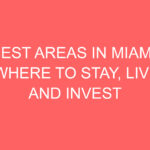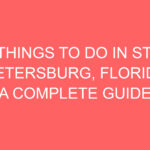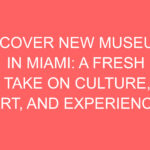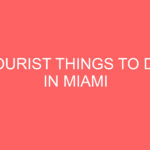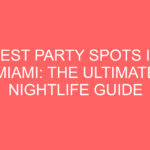Miami isn’t just a destination for beaches and nightlife—it’s also a city deeply rooted in African American and Afro-Caribbean history. From the jazz-filled streets of Historic Overtown to the rhythmic beats echoing through Little Haiti, Miami stands as a cultural crossroads where history, art, and resilience merge. This expanded guide delves even deeper into the city’s most important Black attractions—historic landmarks, cultural centers, festivals, restaurants, and community-driven organizations—painting a fuller picture of Miami’s powerful Black heritage.
1. Historic Landmarks & Sites
- 🏙️ Historic Overtown – Known as the “Harlem of the South,” Overtown was the beating heart of Miami’s Black community during segregation. The district thrived from the 1920s to the 1950s, welcoming icons like Duke Ellington, Billie Holiday, and Josephine Baker. Today, the area continues to evolve, blending history with revitalization projects and cultural tourism. Walking through Overtown, you’ll find murals depicting historical figures, restored theaters, and the echoes of jazz spilling out from local events.
- 🎭 Black Archives Historic Lyric Theater (819 NW 2nd Ave) – Constructed in 1913, the Lyric Theater became one of the few entertainment venues open to Black performers and audiences during segregation. Its stage hosted world-renowned acts while serving as a community center and safe gathering space. After restoration, it now functions as both a museum and a cultural hub, featuring rotating exhibitions, musical performances, and educational programming that honors Miami’s African American legacy.
- 🚔 Black Police Precinct & Courthouse Museum (480 NW 11th St) – Built in 1950, this historic precinct was the first of its kind, created to allow Black officers to serve their community at a time when segregation prevented them from working elsewhere. The museum today offers guided tours led by retired officers, immersive exhibits showcasing vintage uniforms and badges, and emotional storytelling sessions that explore how these pioneers shaped policing and civil rights in Miami.
- ⛪ Mount Zion Missionary Baptist Church – Founded in 1896, Mount Zion is Miami’s oldest Black congregation. The church played a pivotal role in the Civil Rights Movement, hosting leaders like Martin Luther King Jr. Its gothic architecture and stained-glass windows stand as a monument to the faith and perseverance of the community that built it.
- 🏠 Ward Rooming House – This beautifully restored guesthouse was once a refuge for Black travelers and artists barred from staying in white-owned hotels. Today, it operates as a cultural gallery featuring local art, historical photos, and rotating exhibits about Miami’s Black history.
- 🏨 Dunns-Josephine Hotel (1028 NW 3rd Ave) – A tribute to the glamour and defiance of Josephine Baker, this boutique hotel brings Overtown’s cultural renaissance to life. Every room celebrates an era of jazz, soul, and resistance, while the lobby often hosts small art shows and community gatherings.
- 🏖️ Historic Virginia Key Beach Park – Established in 1945 after protests against racial segregation, Virginia Key Beach became a haven for Miami’s Black residents. It hosted family picnics, music festivals, and civil rights rallies. Now restored, the park features walking trails, historical exhibits, and cultural events that keep its powerful legacy alive.
- 🌆 Liberty Square Housing Project – Built in 1937, Liberty Square was one of the first public housing projects for African Americans in the South. It remains a cornerstone of Liberty City’s identity and is being revitalized as part of a modern cultural redevelopment project.
2. Museums & Cultural Centers
- 🎨 Haitian Heritage Museum (4141 NE 2nd Ave, Unit 105-C) – Founded by Eveline Pierre and Serge Rodriguez, this museum is a cornerstone of Haitian pride. Visitors can explore exhibitions of Haitian art, literature, and history while learning about the nation’s role as the first Black republic in the Western Hemisphere.
- 🩰 Little Haiti Cultural Center (212 NE 59th Terrace) – This vibrant community space pulsates with life, offering dance classes, theater performances, and art installations. On weekends, the open-air market bursts with color as locals sell handmade crafts, paintings, and Caribbean spices. The center is also home to the Caribbean Marketplace, an architectural homage to traditional Haitian design.
- 📚 Black Archives, History & Research Foundation – The foundation maintains one of Florida’s most comprehensive archives of African American documents, photographs, and oral histories. Researchers and visitors alike can delve into the stories of the Bahamian immigrants, Black entrepreneurs, and musicians who shaped modern Miami.
- 🎥 Black Police Precinct & Courthouse Museum – In addition to being a historic site, this museum curates special events such as film nights, public lectures, and youth mentorship programs focused on leadership and history.
- 🖼️ HistoryMiami Museum – Black Miami Exhibit – While not exclusively a Black museum, its permanent collection features compelling stories of segregation, migration, and Miami’s evolving multicultural identity.
3. Black-Owned Restaurants & Businesses
- 🍗 Red Rooster Overtown – Celebrity chef Marcus Samuelsson’s celebrated restaurant honors Overtown’s past while serving elevated Southern cuisine. With dishes like shrimp and grits, cornbread, and jerk ribs, it’s a feast for both the palate and the spirit. The rooftop bar often features live jazz and DJs, keeping the energy of the Harlem Renaissance alive.
- 🥘 Lil’ Greenhouse Grill – A cozy neighborhood gem serving soulful favorites with a healthy twist. Locals love their barbecue ribs, collard greens, and sweet potato waffles. The restaurant’s community-first philosophy makes it a gathering place for artists, musicians, and families.
- 🍳 Jackson Soul Food – Since 1946, this family-run institution has been the go-to breakfast spot for hearty Southern comfort food. Its legacy bridges generations and remains one of the longest-running Black-owned eateries in the city.
- 🌶️ Clive’s Jamaican Restaurant – Nestled in Little Haiti, this restaurant offers an explosion of island flavors—jerk chicken, curry goat, and plantains. The aroma alone draws visitors in, while the vibrant decor immerses them in Caribbean culture.
- ☕ Awash Ethiopian Restaurant – A cultural treasure in North Miami Gardens, Awash brings authentic Ethiopian dishes, traditional music, and coffee ceremonies to life. Dining here is both a sensory and educational experience.
- 🍹 Victory Restaurant & Lounge – Located in Midtown, Victory combines Caribbean and Southern fusion with a lively nightlife scene, offering an upscale experience where culture meets celebration.
- 🍽️ Café Abundance – A vegan-friendly, Black-owned café focusing on health-conscious Caribbean and Southern fusion dishes. The café also partners with local charities to provide meals for those in need, reflecting Miami’s community-driven spirit.
- 🥗 House of Mac – Founded by a local DJ-turned-chef, this eatery blends comfort food with modern flair. Signature truffle mac & cheese and jerk chicken pasta draw both locals and tourists.
- 🍰 Sweet Blendz Bakery – A small Black-owned bakery known for Caribbean pastries and rum cakes, celebrating recipes passed down through generations.
These restaurants represent more than food—they’re spaces of connection, storytelling, and pride that keep Miami’s Black culinary heritage thriving.
4. Annual Events & Festivals
- 🎨 Art of Black Miami (Nov–Dec) – This multi-venue festival highlights African diaspora artists during Art Basel season. From pop-up galleries in Overtown to installations in Wynwood, it showcases everything from fine art to street murals. The festival also includes artist panels, workshops, and open studios where visitors can meet local and international artists. Guided tours often take participants through hidden art spaces, and local cafes host live performances to complement the exhibitions.
- 🎷 Jazz in the Gardens (March) – A major highlight of the year, this two-day music festival draws thousands to Hard Rock Stadium. Past headliners include Jill Scott, Earth, Wind & Fire, and Mary J. Blige. The event features food villages spotlighting Black-owned vendors, art markets, and pre-concert community days with local youth performances. VIP experiences include exclusive seating and meet-and-greet opportunities. The festival is more than a concert—it’s a weekend celebration of soul, community, and creativity.
- 🎭 Miami Carnival (October) – A colorful parade of Caribbean culture filled with elaborate costumes, steel drum bands, and infectious soca music. It’s a full sensory experience celebrating the diversity of the African diaspora in South Florida. In addition to the grand parade, the event features a weekend-long festival with food stalls, dance competitions, and cultural storytelling sessions. Visitors can join costume-making workshops or learn traditional Caribbean dances during community classes leading up to the carnival.
- 🎶 Haitian Compas Festival (May) – The world’s largest celebration of Haitian music, attracting international artists and thousands of fans. Expect dance, laughter, and delicious Creole street food. The festival also includes cultural exhibitions, art installations, and panel discussions exploring Haitian history and influence in Miami. Daytime family events turn into vibrant night performances, creating a full-day immersion in Haitian rhythm and pride.
- 🚶♀️ Historic Overtown Legacy Trek (Monthly) – A guided walk through Overtown’s landmarks led by local historians, combining storytelling with community engagement. Participants explore historic churches, theaters, and street murals while learning about the figures who shaped Miami’s cultural identity. Some treks include food tastings at Black-owned restaurants and live performances from local musicians. It’s both educational and entertaining—a living history experience.
- 🎡 Folklife Fridays (Oct–Apr) – A downtown cultural celebration of live music, artisan crafts, and international cuisine. It’s a melting pot of cultures and an ongoing showcase of Miami’s Black creative energy. The event transforms Miami’s downtown plaza into a lively festival ground every week, featuring spoken word artists, reggae bands, and pop-up shops selling handmade goods. Families, tourists, and locals gather to enjoy performances, food trucks, and cultural showcases that keep Miami’s artistic heartbeat alive throughout the cooler months.
5. Black Heritage Tours
- 🚶 Overtown Walking Tour – Explore the neighborhood’s murals, churches, and historic theaters with a local historian who brings decades of oral history to life. Participants visit landmarks like the Lyric Theater, Ward Rooming House, and Mt. Zion Church while learning about the jazz legends and civil rights leaders who once walked these streets. The tours often include live storytelling, community meet-ups, and local food tastings. Visitors can also purchase handmade souvenirs from local artisans who share their family legacies through art.
- 🚌 Cultural Heritage Alliance Tours – A comprehensive and immersive bus tour connecting Liberty City, Overtown, and Little Haiti. Guides weave together Miami’s past and present through storytelling, cultural music, and stops at restaurants and galleries. Guests have opportunities to meet local business owners, artists, and chefs, getting firsthand insight into how these communities are preserving and evolving their heritage. Extended versions of the tour include workshops on traditional Caribbean cooking, African drumming sessions, and heritage storytelling for children. It’s a full-day journey into the heart of Black Miami.
- 📅 Historic Overtown Legacy Trek – This monthly event organized by the City of Miami combines education and entertainment, making it ideal for first-time visitors and history enthusiasts alike. The guided trek explores hidden corners of Overtown, highlighting the role of churches, civic centers, and artists in the city’s early development. Participants often end the tour with community gatherings featuring live music, poetry readings, and food from Black-owned restaurants. It’s not just a walk—it’s a cultural experience that connects the past with the present.
- 🎧 Self-Guided Digital Tours – Apps and online platforms now offer self-paced walking tours enhanced by GPS navigation, archival photos, and voice narration. Users can explore Miami’s heritage sites at their own pace, listening to stories told by local historians and descendants of early residents. Some tours offer augmented reality experiences, showing how neighborhoods looked decades ago. Others include interactive maps with restaurant suggestions, historical trivia, and even bonus audio from community elders sharing memories of the Civil Rights era.
6. Neighborhoods Rich in Black Culture
- 🏙️ Overtown – The birthplace of Miami’s Black identity, filled with heritage buildings, community centers, and historic eateries. Once the cultural and social nucleus for Miami’s Black population, it was home to jazz clubs that hosted icons like Duke Ellington and Louis Armstrong. Visitors today can explore murals, live music spots, and cultural festivals that bring its history to life. Overtown also offers guided tours, where locals share stories about how the neighborhood continues to rebuild while preserving its cultural heart.
- 🏠 Liberty City – Known for its activism, Liberty City was the birthplace of numerous civil rights movements in South Florida. The area features historic landmarks, community-driven art projects, and grassroots organizations that empower youth through education and culture. The Liberty City Farmers Market and African Heritage Cultural Arts Center showcase the neighborhood’s vibrancy. Visitors can enjoy outdoor murals, soul food restaurants, and locally organized block parties celebrating unity and resilience.
- 🎭 Little Haiti – A sensory explosion of Caribbean rhythm and art, Little Haiti blends Haitian heritage with Miami’s creative pulse. Visitors can stroll through colorful markets, admire hand-painted storefronts, and listen to live compas and zouk music. The area also houses the Little Haiti Cultural Complex, Haitian Heritage Museum, and street murals depicting Haiti’s independence. Every weekend, the sounds of drumming and dance spill onto the streets, creating an atmosphere that’s both festive and deeply cultural.
- 🌴 West Coconut Grove – Originally founded by Bahamian laborers in the late 1800s, this neighborhood still reflects its Caribbean roots through architecture, cuisine, and community events. Visitors can see historic wooden cottages, attend cultural festivals like the Goombay Festival, and explore Bahamian-influenced restaurants and art galleries. The area’s lush greenery and old-world charm make it a peaceful retreat steeped in Miami’s earliest Black heritage.
- 🎶 Miami Gardens – Florida’s largest predominantly Black city and a thriving hub for modern culture. It’s home to Jazz in the Gardens, a nationally recognized music festival celebrating R&B, gospel, and hip-hop. Beyond music, Miami Gardens is rich in community spirit, offering public art installations, farmers markets, and cultural centers that support young creatives. Visitors can enjoy concerts, Caribbean cuisine, and community events that highlight Miami’s evolving Black excellence.
7. Community Organizations & Cultural Hubs
- 🤝 The Black Archives Foundation – A vital institution preserving Florida’s Black legacy through archival projects, oral histories, and exhibitions. Established in 1977 by Dr. Dorothy Jenkins Fields, the foundation houses thousands of historical documents, photos, and audiovisual materials. It frequently partners with schools and universities to create educational programs that highlight the role of African Americans in building modern Miami. Visitors can explore curated exhibitions on jazz history, civil rights, and the Harlem Renaissance in the South.
- 🎨 Little Haiti Cultural Complex – Continues to expand its role as a creative incubator for artists, musicians, and dancers from across the Caribbean. In addition to hosting art shows, theater productions, and cultural festivals, it also offers year-round classes in drumming, ceramics, and visual arts. The complex serves as a social hub where community members come together to preserve Haitian language and traditions. The attached Caribbean Marketplace offers handcrafted items, clothing, and local food that reflect the neighborhood’s vibrant identity.
- 🚌 Cultural Heritage Alliance (CHAT) – Empowers minority-owned tour companies and local entrepreneurs through cultural tourism initiatives. CHAT operates guided tours across Miami’s historic Black neighborhoods, connecting travelers with artisans, chefs, and storytellers. It also supports economic development by training local guides, offering business workshops, and promoting heritage-based tourism as a sustainable industry. Its mission is to ensure that cultural preservation goes hand-in-hand with community prosperity.
- 🏛️ Miami-Dade Black Affairs Advisory Board – Advocates for social equity and organizes large-scale events like the Miami Black History Month Gala. Beyond advocacy, the board provides policy recommendations on education, economic opportunity, and civic engagement for Black residents in Miami-Dade County. It also sponsors mentorship programs, college scholarships, and cultural initiatives aimed at empowering youth and supporting entrepreneurs. Their events often serve as networking platforms for civic leaders, artists, and activists.
- 💡 The Urban Collective – A creative retail space in Little Haiti showcasing local Black artisans, fashion designers, and photographers. The store doubles as a gallery and event venue, hosting pop-up art shows, workshops, and community conversations. It’s known for promoting conscious consumerism—encouraging visitors to support sustainable, locally made products. The Urban Collective has become a symbol of modern Black entrepreneurship in Miami, blending commerce, creativity, and cultural pride.
Visiting Tips
- 📍 Plan Your Route Strategically: Many attractions are within short driving distance of each other. Consider spending a full day in Overtown and another in Little Haiti. Map out nearby museums, restaurants, and historic landmarks to maximize your visit. Bring comfortable walking shoes, water, and sunscreen, as many cultural districts encourage exploration on foot. Group attractions by neighborhood to save time and allow for spontaneous discoveries like murals or pop-up events.
- 🎉 Time Your Visit Around Events: Plan to coincide with signature festivals such as Art of Black Miami or Jazz in the Gardens for vibrant energy. These festivals feature open-air concerts, live art, and street food from Black-owned vendors. Booking early ensures better deals and access to VIP sections. Evening visits bring live performances and DJs that animate areas like Overtown and Little Haiti.
- 🛍️ Support Black-Owned Businesses: Shop locally, buy handmade crafts, and dine at family-run restaurants. Visit community markets such as the Caribbean Marketplace for artisanal jewelry, Haitian paintings, and organic skincare. Purchasing from these stores helps sustain Miami’s creative economy and supports families preserving cultural traditions.
- 🌐 Stay Connected Online: Follow social media accounts of cultural centers for exhibit updates, festivals, and open mic nights. Organizations like the Little Haiti Cultural Complex and The Black Archives often share upcoming workshops, residencies, and volunteer opportunities through Instagram and newsletters.
- 🚗 Plan Transportation: Parking can be limited near Overtown and Liberty City during events—arrive early or use ride-share services. Street parking fills quickly near The Lyric Theater and Red Rooster Overtown. Public transit or the free Miami Trolley are convenient options. Eco-conscious visitors can opt for bike or scooter rentals available near cultural hubs.
Conclusion
From the soul-stirring hymns at Mount Zion to the rhythmic drums of Little Haiti, every corner of Miami tells a story of endurance and cultural pride. The city’s Black heritage is not confined to history—it lives on through art, cuisine, music, and community. Visiting these attractions isn’t just about sightseeing; it’s an invitation to connect with Miami’s spirit, to celebrate the generations that built it, and to honor the cultural heartbeat that continues to inspire and empower all who experience it.
